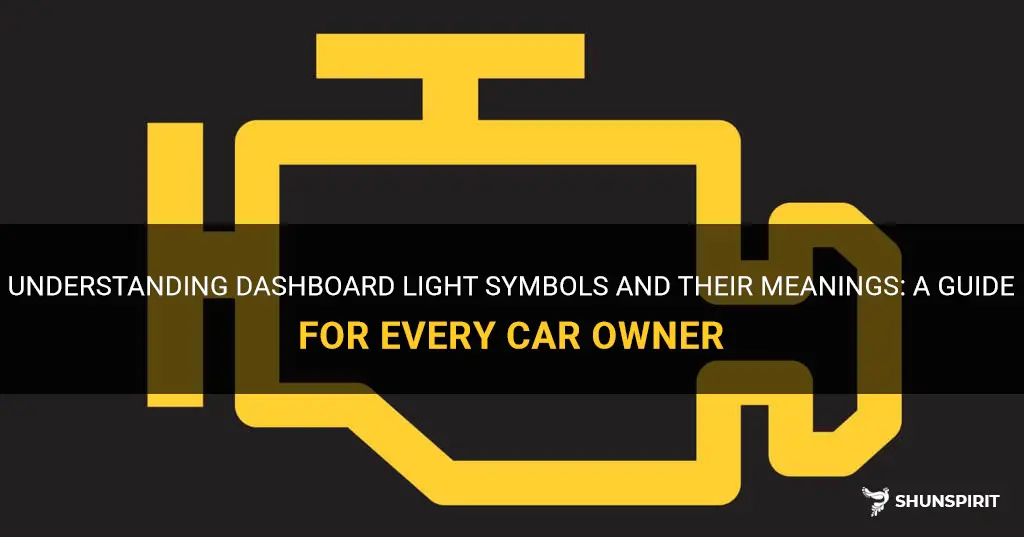
Dashboard light symbols are important indicators that provide drivers with crucial information about the status and condition of their vehicles. These symbols vary from basic warning lights that signal potential problems to advanced indicators that monitor specific functions of the car. Understanding the meanings behind these symbols can help drivers identify and address issues before they become larger, more costly problems. Whether it's a simple check engine light or a complex symbol related to the car's traction control system, this guide will decode the mystery of dashboard light symbols and empower drivers to make informed decisions on the road.
What You'll Learn
- What are some common dashboard light symbols and their meanings?
- How can I determine what a specific dashboard light symbol means in my vehicle?
- What are the most important dashboard light symbols that should never be ignored?
- Are there any dashboard light symbols that indicate a serious issue with the vehicle?
- Can dashboard light symbols differ between different car models and manufacturers?

What are some common dashboard light symbols and their meanings?
Dashboard lights are important indicators that provide drivers with information about the status of their vehicle. Understanding the meaning of these lights is crucial for maintaining the safety and reliability of the vehicle. Here are some common dashboard light symbols and their meanings:
- Check Engine Light: This light usually appears as an engine-shaped symbol. It indicates a problem with the vehicle's engine or emission control system. It could be as simple as a loose gas cap or a more serious issue that requires immediate attention from a mechanic.
- Battery Light: This light looks like a battery and indicates a problem with the vehicle's charging system. It could be a faulty alternator, a loose belt, or a dying battery. Ignoring this light could lead to a dead battery and a stranded vehicle.
- Oil Pressure Light: This symbol typically resembles an oil can or a dripping oil drop. It alerts the driver that the engine oil pressure is low or that there is a problem with the oil system. Driving with low oil pressure can cause severe engine damage, so it is important to stop the vehicle and check the oil level and pressure immediately.
- Tire Pressure Monitoring System (TPMS) Light: The TPMS light looks like a flat tire with an exclamation mark inside. It indicates that one or more of the tires have low air pressure. Low tire pressure can affect the vehicle's handling and fuel efficiency, so it is important to check the tire pressure and inflate them to the recommended level.
- ABS Light: The ABS light stands for the Anti-lock Braking System. It typically appears as the letters ABS inside a circle. This light indicates a problem with the ABS system, which could affect the vehicle's braking ability. It is important to have the ABS system checked by a professional as soon as possible.
- Airbag Light: The airbag light looks like a seated person with a large circle in front. It indicates a problem with the vehicle's airbag system. If this light stays on, it means that the airbags may not deploy in the event of an accident. It is essential to have the airbag system inspected and repaired by a qualified technician.
- Coolant Temperature Light: This light usually looks like a thermometer or a wavy line with an arrow pointing up. It indicates that the engine coolant temperature is too high, possibly due to a cooling system malfunction or low coolant level. Continued driving with an overheated engine can cause severe damage, so it is necessary to pull over, turn off the engine, and wait for it to cool down before inspecting the coolant level or calling for assistance.
- Fuel Warning Light: The fuel warning light appears as a fuel pump symbol. It indicates that the fuel level is low and the vehicle needs to be refueled soon. Ignoring this light can cause the vehicle to run out of fuel, leaving the driver stranded.
These are just a few of the most common dashboard light symbols and their meanings. It is essential to consult the vehicle's owner's manual to familiarize yourself with the specific lights and their corresponding meanings for your vehicle. As a responsible driver, it is crucial to address any dashboard light promptly to ensure the safety and reliability of your vehicle on the road.
The Rich Symbolism and Fascinating Meanings Behind Mesopotamian Symbols
You may want to see also

How can I determine what a specific dashboard light symbol means in my vehicle?
When a dashboard light symbol illuminates in your vehicle, it can be quite concerning. However, understanding what these symbols mean can help you determine if there is a minor issue that can be resolved or if immediate attention from a mechanic is required. Here are some steps you can take to determine what a specific dashboard light symbol means in your vehicle.
- Consult your vehicle's owner's manual: The first step in understanding dashboard light symbols is to consult your vehicle's owner's manual. The manual will contain a section that provides explanations for each symbol on your dashboard. Look for a section titled "Warning Lights" or something similar. It will typically provide a comprehensive list of symbols along with their meanings.
- Use online resources: If you don't have access to your vehicle's owner's manual or can't find the necessary information, you can turn to online resources. There are various websites that provide detailed explanations for dashboard light symbols. Simply search for the make, model, and year of your vehicle along with the specific symbol you're trying to identify. This should lead you to websites that have information specific to your car.
- Visit a mechanic: If you're unable to determine the meaning of a specific dashboard light symbol using the above methods or if you're unsure about the severity of the issue, it's best to visit a mechanic. They have the expertise to diagnose and fix any problems with your vehicle. It's always better to be safe than sorry, so don't hesitate to seek professional help.
- Pay attention to the light's color and behavior: Sometimes, the color and behavior of the dashboard light can give you a clue about its meaning. For example, a red light generally indicates a more severe problem that requires immediate attention, while a yellow or orange light may indicate a less urgent issue. Additionally, the blinking or flashing of a light can signify an active problem, while a solid light can indicate a system is on or functioning properly.
In conclusion, determining the meaning of a specific dashboard light symbol in your vehicle requires consulting your owner's manual, using online resources, visiting a mechanic if needed, and paying attention to the color and behavior of the light. Understanding these symbols will help you take the appropriate action to address any issues with your vehicle and ensure your safety on the road.
The Hidden Meanings Behind Chinese Symbols Tattoos: Unveiling Cultural Significance and Symbolism
You may want to see also

What are the most important dashboard light symbols that should never be ignored?
Dashboard lights are an essential part of a vehicle's safety system, as they indicate any potential issues or problems that need attention. While some lights are simply informative, others are indicative of critical problems that should never be ignored.
Here are some of the most important dashboard light symbols that should never be ignored:
- Check Engine Light: This light typically indicates a problem with the engine or emission control system. It could be something as simple as a loose fuel cap or a more serious issue. Ignoring this light could lead to further damage to the engine and costly repairs in the future.
- Oil Pressure Light: This light indicates that there is a problem with the vehicle's oil pressure. Low oil pressure can cause engine damage, so it is crucial to address this issue immediately. Stop the vehicle and check the oil level. If it is low, add oil. If the light stays on, it is advisable to seek professional help.
- Battery Light: The battery light indicates that the vehicle's charging system is not working correctly. It could be a problem with the battery, alternator, or other electrical components. Ignoring this light could lead to a dead battery and potential breakdown.
- Brake Warning Light: This light indicates a problem with the brake system. It could indicate low brake fluid, a worn brake pad, or a malfunctioning brake system. Ignoring this light could compromise your safety and increase the risk of an accident. It is best to have the brake system inspected as soon as possible.
- ABS Light: The ABS (Anti-lock Braking System) light indicates a problem with the ABS system. This system helps prevent skidding during sudden stops. Ignoring this light could affect the vehicle's ability to stop safely in emergencies.
- Airbag Light: The airbag light indicates a problem with the vehicle's airbag system. Ignoring this light could mean that the airbags may not deploy correctly in the event of an accident. It is crucial to have this system inspected and repaired by a professional.
- Temperature Warning Light: This light indicates that the vehicle's engine is overheating. It could be a problem with the coolant level or a malfunctioning cooling system. Ignoring this light could cause severe engine damage and potentially leave you stranded.
- Tire Pressure Warning Light: This light indicates that one or more of the vehicle's tires have low pressure. Driving with low tire pressure can result in reduced traction, poor handling, and increased risk of a blowout. It is essential to check and adjust the tire pressure as soon as possible.
- Transmission Warning Light: This light indicates a problem with the vehicle's transmission system. Ignoring this light could cause further damage and potentially leave you stranded. It is advisable to have the transmission system inspected by a professional.
It is crucial to pay attention to these dashboard light symbols and take appropriate action when they illuminate. Ignoring these warning signs could result in further damage to the vehicle and compromise your safety on the road. When in doubt, it is always best to consult a professional mechanic to diagnose and fix the underlying issue.
Unveiling the Mystical Meanings of Talisman Symbols
You may want to see also

Are there any dashboard light symbols that indicate a serious issue with the vehicle?
Whenever you're driving, it's important to pay attention to the dashboard lights of your vehicle. These lights are there to alert you about any potential issues with your car. While some dashboard lights indicate minor issues, there are also symbols that signal a more serious problem that requires immediate attention. Here are a few dashboard light symbols you should never ignore:
- Engine Temperature Warning Light: This symbol looks like a thermometer or a radiator. It indicates that your engine is overheating and could potentially cause significant damage to the vehicle. When you see this light, it's crucial to pull over and let your engine cool down before continuing to drive.
- Battery Warning Light: The battery symbol usually looks like a rectangle with a positive and a negative sign. When this light comes on, it means there is a problem with your vehicle's charging system. Ignoring this light could result in a dead battery and potentially leave you stranded on the road.
- Oil Pressure Warning Light: This symbol typically looks like an oil can. If you see this light on your dashboard, it means that there is a drop in oil pressure, which could lead to severe engine damage if not addressed promptly. It's essential to stop driving and check your oil level or call for roadside assistance.
- Brake System Warning Light: This symbol usually appears as an exclamation mark inside a circle or parentheses. It indicates a problem with your vehicle's braking system. Ignoring this light could compromise your safety and the safety of other drivers on the road. It's best to have your brakes inspected immediately.
- Airbag Warning Light: The airbag symbol looks like a person with a round circle in front. If this light comes on, it means there is a problem with your vehicle's airbag system. Airbags are crucial for your safety in the event of an accident, so it's important to have this issue resolved as soon as possible.
- ABS Warning Light: The ABS symbol usually looks like the letters "ABS" inside a circle. When this light illuminates, it means there is an issue with your vehicle's anti-lock braking system. Although your regular brakes may still work, the anti-lock feature may not be functioning correctly, potentially affecting your ability to brake in certain situations.
- Transmission Temperature Warning Light: This symbol resembles a thermometer inside a gear. It indicates that your transmission is overheating. Continuing to drive with an overheating transmission can cause severe damage and may require costly repairs. It's advisable to pull over and let your transmission cool down before resuming your journey.
These are just a few examples of dashboard light symbols that indicate serious issues with your vehicle. It's crucial to familiarize yourself with the symbols specific to your car and consult your vehicle's owner's manual for more information. If any of these warning lights illuminate while you're driving, it's important to address the issue promptly to prevent further damage and ensure your safety on the road.
Decoding the Hidden Meanings Behind France's National Symbols
You may want to see also

Can dashboard light symbols differ between different car models and manufacturers?
Dashboard light symbols can indeed differ between different car models and manufacturers. While there are some universal symbols that are consistent across most vehicles, manufacturers also include their own unique icons to represent specific features or warnings.
The universal symbols are standardized by organizations such as the International Organization for Standardization (ISO) and the Society of Automotive Engineers (SAE). These symbols are meant to convey crucial information to drivers about their vehicle's status or potential issues. Some common universal symbols include the check engine light, tire pressure warning, battery warning, and oil pressure warning.
However, manufacturers can also include their own unique symbols to provide additional information or differentiate their vehicles from competitors. For example, a luxury car manufacturer may have specific icons to indicate features such as lane departure warning, adaptive cruise control, or blind-spot detection. These symbols may not be found in lower-end vehicles or vehicles from a different manufacturer.
Additionally, manufacturers may design their dashboard light symbols to align with their brand identity. This can include using specific colors or shapes that are consistent with their logo or overall design aesthetic. For example, a sports car manufacturer may use red icons to indicate performance-related features or warnings, while a family-oriented manufacturer may use more muted colors and symbols to prioritize safety and reliability.
It is important for drivers to consult their vehicle's owner's manual to familiarize themselves with the specific dashboard light symbols used in their car. This will help drivers understand the meaning behind each symbol and take appropriate action when necessary. Ignoring or misinterpreting a dashboard light symbol can lead to potential safety hazards or expensive repairs.
In conclusion, while there are some universal dashboard light symbols, manufacturers can include their own unique icons to represent specific features or warnings. Drivers should consult their vehicle's owner's manual to understand the specific symbols used in their car and take appropriate action when necessary.
Unlocking the Hidden Meanings Behind Cool Symbols
You may want to see also
Frequently asked questions
The check engine light symbol usually indicates that there is a problem with the vehicle's emissions system. It could be something as simple as a loose gas cap or a more serious issue with the engine or exhaust system. It is important to have the vehicle checked by a mechanic as soon as possible to diagnose and fix the problem.
The battery light symbol typically indicates a problem with the vehicle's electrical system. It could mean that the battery is not charging properly, there is a problem with the alternator, or there is a wiring issue. If the battery light comes on while driving, it is important to get the vehicle to a safe location and have it checked by a mechanic as soon as possible to prevent a breakdown.
The oil pressure light symbol usually indicates that there is a problem with the vehicle's oil pressure. It could mean that the oil level is low, there is a problem with the oil pump, or there is a blockage in the oil filter. It is essential to stop the vehicle immediately if the oil pressure light comes on to prevent engine damage. Check the oil level and add oil if necessary, but it is recommended to have the vehicle inspected by a mechanic to determine the cause of the low oil pressure.
The TPMS light symbol indicates that one or more of the vehicle's tires has low tire pressure. It is a warning to check the tire pressure and inflate the tires to the recommended level. Driving with low tire pressure can affect the vehicle's handling and fuel efficiency and increase the risk of a tire blowout. It is important to address the low tire pressure as soon as possible by inflating the tires or repairing any leaks.







